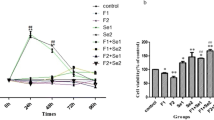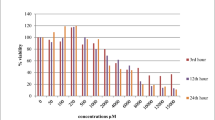Abstract
Fluoride is widely distributed in nature, and at high concentrations, it targets the kidney and especially proximal tubule epithelial cells. Selenium is a typical trace element beneficial to humans, and the role of selenium in the prevention and treatment of fluoride-induced organ damage is an important research topic. The purpose of this study was to investigate the possible protective effects of selenium against fluoride-induced oxidative stress and apoptosis in rat renal tubular epithelial cells. We showed that the activity of antioxidant enzymes (superoxide dismutase and glutathione peroxidase) and total antioxidant capacity were significantly reduced in NaF-treated normal rat kidney cells (NRK-52E), whereas the levels of nitrogen monoxide (NO) and malondialdehyde (MDA) were significantly increased. Moreover, the number of apoptotic cells, mRNA expression of Bax, Bad, caspase-3, caspase-8, and caspase-9, and protein expression of Bax were elevated, while mitochondrial membrane potential and the protein expression of Bcl-2 were reduced. Compared with the NaF group, pretreatment with selenium enhanced the activity of antioxidant enzymes, mitochondrial membrane potential, and protein expression of Bcl-2, while the levels of NO and MDA, number of apoptotic cells, mRNA expression of Bax, Bad, caspase-3, caspase-8, and caspase-9, and protein expression of Bax were decreased. In conclusion, selenium exerted remarkable protective effect against NaF-induced oxidative stress and apoptosis and altered the expression of Bcl-2/caspase family.







Similar content being viewed by others
References
Chen L, Chen HQ, Yao C, Chang C, Xia HC, Zhang CX, Zhou Y, Yao Q, Chen KP (2015) The toxicity of NaF on BmN cells and a comparative proteomics approach to identify protein expression changes in cells under NaF-stress: impact of NaF on BmN cells. J Hazard Mater 286(9):624–631. https://doi.org/10.1016/j.jhazmat.2014.12.056
WHO (1993) Guidelines for Drinking Water Quality, 45. World Health Organization, Geneva
Luo Q, Guo HR, Kuang P, Cui HM, Deng HD, Liu H, Lu YJ, Wei Q, Chen LL, Fang J, Zuo ZC, Deng JJ, Li YL, Wang X, Zhao L (2018) Sodium fluoride arrests renal G2/M phase cell-cycle progression by activating ATMChk2-P53/Cdc25C signaling pathway in mice. Cell Physiol Biochem 51(5):2421–2433. https://doi.org/10.1159/000495899
Tang WHW, Li DY, Hazen SL (2019) Dietary metabolism, the gut microbiome, and heart failure. Nat Rev Cardiol 16(3):137–154. https://doi.org/10.1038/s41569-018-0108-7
Usuda K, Kono K, Dote T, Nishiura K, Miyata K, Nishiura H, Shimahara M, Sugimoto K (1998) Urinary biomarkers monitoring for experimental fluoride nephrotoxicity. Arch Toxicol 72(2):104–109. https://doi.org/10.1007/s002040050475
Cao J, Chen J, Wang J, Jia R, Xue W, Luo Y, Gan X (2013) Effects of fluoride on liver apoptosis and Bcl-2, Bax protein expression in freshwater teleost, Cyprinus carpio. Chemosphere 91(8):1203–1212. https://doi.org/10.1016/j.chemosphere.2013.01.037
Zhang Z, Zhou B, Wang H, Wang F, Song Y, Liu S, Xi S (2014) Maize purple plant pigment protects against fluoride-induced oxidative damage of liver and kidney in rats. Int J Environ Res Public Health 11(1):1020–1033. https://doi.org/10.3390/ijerph110101020
Dong N, Feng J, Xie J, Tian X, Li M, Liu P, Zhao Y, Wei C, Gao Y, Li B, Qiu Y, Yan X (2019) Co-exposure to arsenic-fluoride results in endoplasmic reticulum stress-induced apoptosis through the PERK signaling pathway in the liver of offspring rats. https://doi.org/10.1007/s12011-019-01975-1
Alhusaini AM, Faddah LM, El Orabi NF, Hasan IH (2018) Role of some natural antioxidants in the modulation of some proteins expressions against sodium fluoride-induced renal injury. Biomed Res Int 2018:5614803. 10.1155/2018/5614803, 9
Naziroglu M (2009) Role of selenium on calcium signaling and oxidative stress-induced molecular pathways in epilepsy. Neurochem Res 34(12):2181–2191. https://doi.org/10.1007/s11064-009-0015-8
Zheng X, Sun Y, Ke L, Ouyang W, Zhang Z (2016) Molecular mechanism of brain impairment caused by drinking-acquired fluorosis and selenium intervention. Environ Toxicol Pharmacol 43:134–139. https://doi.org/10.1016/j.etap.2016.02.017
Miao K, Zhang L, Yang S, Qian W, Zhang Z (2013) Intervention of selenium on apoptosis and Fas/FasL expressions in the liver of fluoride-exposed rats. Environ Toxicol Pharmacol 36(3):913–920. https://doi.org/10.1016/j.etap.2013.08.003
Qian W, Miao K, Li T, Zhang Z (2013) Effect of selenium on fluoride-induced changes in synaptic plasticity in rat hippocampus. Biol Trace Elem Res 155(2):253–260. https://doi.org/10.1007/s12011-013-9773-x
Feng P, Wei JR, Zhang ZG (2012) Influence of selenium and fluoride on blood antioxidant capacity of rats. Experimental and toxicologic pathology: official journal of the Gesellschaft fur Toxikologische Pathologie 64(6):565–568. https://doi.org/10.1016/j.etp.2010.11.014
Wang GZ, Niu ZX (2011) The progress study of toxicity of selenium. Northwest Pharm J 25(3):237–238
Rayman MP (2000) The importance of selenium to human health. Lancet (London, England) 356(9225):233–241. https://doi.org/10.1016/s0140-6736(00)02490-9
Dharmaratne RW (2019) Exploring the role of excess fluoride in chronic kidney disease: a review. Hum Exp Toxicol 38(3):269–279. https://doi.org/10.1177/0960327118814161
Tian X, Feng J, Dong N, Lyu Y, Wei C, Li B, Ma Y, Xie J, Qiu Y, Song G, Ren X, Yan X (2019) Subchronic exposure to arsenite and fluoride from gestation to puberty induces oxidative stress and disrupts ultrastructure in the kidneys of rat offspring. Sci Total Environ 686:1229–1237. https://doi.org/10.1016/j.scitotenv.2019.04.409
Dhar V, Bhatnagar M (2009) Physiology and toxicity of fluoride. Indian J Dent Res 20:350–355
Xu H, Hu LS, Chang M, Jing L, Zhang XY, Li GS (2005) Proteomic analysis of kidney in fluoride-treated rat. Toxicol Lett 160(1):69–75. https://doi.org/10.1016/j.toxlet.2005.06.009
Nabavi SF, Moghaddam AH, Eslami S, Nabavi SM (2012) Protective effects of curcumin against sodium fluoride-induced toxicity in rat kidneys. Biol Trace Elem Res 145(3):369–374. https://doi.org/10.1007/s12011-011-9194-7
Ke L, Zheng X, Sun Y, Ouyang W, Zhang Z (2016) Effects of sodium fluoride on lipid peroxidation and PARP, XBP-1 expression in PC12 cell. Biol Trace Elem Res 173(1):161–167. https://doi.org/10.1007/s12011-016-0641-3
Akdogan M, Kaleli S, Yazar H, Desdicioglu R, Yuvaci H (2016) Effect of high-dose fluoride on antioxidant enzyme activities of amniotic fluid in rats. JPMA J Pakistan Medical Assoc 66(4):435–438
Nabavi SM, Habtemariam S, Nabavi SF, Sureda A, Daglia M, Moghaddam AH, Amani MA (2013) Protective effect of gallic acid isolated from Peltiphyllum peltatum against sodium fluoride-induced oxidative stress in rat's kidney. Mol Cell Biochem 372(1–2):233–239. https://doi.org/10.1007/s11010-012-1464-y
Baba N, Raina R, Verma P, Sultana M (2016) Free radical-induced nephrotoxicity following repeated oral exposureto chlorpyrifos alone and in conjunction with fluoride in rats. Turkish J Med Sci 46(2):512–517. https://doi.org/10.3906/sag-1403-109
Shuhua X, Ziyou L, Ling Y, Fei W, Sun G (2012) A role of fluoride on free radical generation and oxidative stress in BV-2 microglia cells. Mediat Inflamm 2012:102954. 10.1155/2012/102954, 8
Zhang H, Zhang HM, Wu LP, Tan DX, Kamat A, Li YQ, Katz MS, Abboud HE, Reiter RJ, Zhang BX (2011) Impaired mitochondrial complex III and melatonin responsive reactive oxygen species generation in kidney mitochondria of db/db mice. J Pineal Res 51(3):338–344. https://doi.org/10.1111/j.1600-079X.2011.00894.x
Bergandi L, Aina V, Malavasi G, Morterra C, Ghigo D (2011) The toxic effect of fluoride on MG-63 osteoblast cells is also dependent on the production of nitric oxide. Chem Biol Interact 190(2–3):179–186. https://doi.org/10.1016/j.cbi.2011.02.003
Macotpet A, Suksawat F, Sukon P, Pimpakdee K, Pattarapanwichien E, Tangrassameeprasert R, Boonsiri P (2013) Oxidative stress in cancer-bearing dogs assessed by measuring serum malondialdehyde. BMC Vet Res 9:101. https://doi.org/10.1186/1746-6148-9-101
Hassan HA, Abdel-Aziz AF (2010) Evaluation of free radical-scavenging and anti-oxidant properties of black berry against fluoride toxicity in rats. Food and chemical toxicology: an international journal published for the British Industrial Biological Research Association 48(8–9):1999–2004. https://doi.org/10.1016/j.fct.2010.05.018
Cheng EH, Kirsch DG, Clem RJ, Ravi R, Kastan MB, Bedi A, Ueno K, Hardwick JM (1997) Conversion of Bcl-2 to a Bax-like death effector by caspases. Science (New York, NY) 278(5345):1966–1968. https://doi.org/10.1126/science.278.5345.1966
Lopez J, Tait SW (2015) Mitochondrial apoptosis: killing cancer using the enemy within. Br J Cancer 112(6):957–962. https://doi.org/10.1038/bjc.2015.85
Sharpe JC, Arnoult D, Youle RJ (2004) Control of mitochondrial permeability by Bcl-2 family members. Biochim Biophys Acta 1644(2–3):107–113. https://doi.org/10.1016/j.bbamcr.2003.10.016
Hu XY, Liang JY, Guo XJ, Liu L, Guo YB (2015) 5-Fluorouracil combined with apigenin enhances anticancer activity through mitochondrial membrane potential (DeltaPsim)-mediated apoptosis in hepatocellular carcinoma. Clin Exp Pharmacol Physiol 42(2):146–153. https://doi.org/10.1111/1440-1681.12333
Zhang L, Cheng X, Gao Y, Bao J, Guan H, Lu R, Yu H, Xu Q, Sun Y (2016) Induction of ROS-independent DNA damage by curcumin leads to G2/M cell cycle arrest and apoptosis in human papillary thyroid carcinoma BCPAP cells. Food Funct 7(1):315–325. https://doi.org/10.1039/c5fo00681c
Park C, Cha HJ (2019) Protective effect of phloroglucinol on oxidative stress-induced DNA damage and apoptosis through activation of the Nrf2/HO-1 signaling pathway in HaCaT human keratinocytes.Mar Drugs. 17 (4):225. https://doi.org/10.3390/md17040225
Wang YX, Xiao X, Zhan XA (2018) Antagonistic effects of different selenium sources on growth inhibition, oxidative damage, and apoptosis induced by fluorine in broilers. Poult Sci 97(9):3207–3217. https://doi.org/10.3382/ps/pey19
Yan X, Wang L, Yang X, Qiu Y, Tian X, Lv Y, Tian F, Song G, Wang T (2017) Fluoride induces apoptosis in H9c2 cardiomyocytes via the mitochondrial pathway. Chemosphere 182:159–165. https://doi.org/10.1016/j.chemosphere.2017.05.002
Eno CO, Zhao G, Olberding KE, Li C (2012) The Bcl-2 proteins Noxa and Bcl-xL co-ordinately regulate oxidative stress-induced apoptosis. Biochem J 444(1):69–78. https://doi.org/10.1042/bj20112023
Fan D, Fan TJ (2017) Clonidine induces apoptosis of human corneal epithelial cells through death receptors-mediated, mitochondria-dependent signaling pathway. Toxicol Sci 156(1):252–260. https://doi.org/10.1093/toxsci/kfw249
Ying J, Xu J, Shen LP, Mao ZJ, Liang JC, Lin SX, Yu XY, Pan RW, Yan CX, Li SB, Bao QY, Li PZ (2017) The effect of sodium fluoride on cell apoptosis and the mechanism of human lung BEAS-2B cells in vitro. Biol Trace Elem Res 179:59–69. https://doi.org/10.1007/s12011-017-0937-y
Desagher S, Martinou JC (2000) Mitochondria as the central control point of apoptosis. Trends Cell Biol 10(9):369–377. https://doi.org/10.1016/S0962-8924(00)01803-1
Siddiqui WA, Ahad A, Ahsan H (2015) The mystery of BCL2 family: Bcl-2 proteins and apoptosis: an update. Arch Toxicol 89(3):289–317. https://doi.org/10.1007/s00204-014-1448-7
Li WS, Jiang BH, Cao XL, Xie YJ, Huang T (2017) Protective effect of lycopene on fluoride-induced ameloblasts apoptosis and dental fluorosis through oxidative stress-mediated Caspase pathways. Chemico-biological interactions 261:27–34. https://doi.org/10.1016/j.cbi.2016.11.021
Funding
This work was financed by grants from the China National Natural Science Foundation (No.31240009), the Special Funds for Experimental Animal Technologies in Shanxi Province of China (No.2012K02), and the Shanxi Scholarship Council of China (Grant No.2016-056).
Author information
Authors and Affiliations
Corresponding author
Ethics declarations
Conflict of Interest
The authors declare that they have no conflict of interest.
Additional information
Publisher’s Note
Springer Nature remains neutral with regard to jurisdictional claims in published maps and institutional affiliations.
Rights and permissions
About this article
Cite this article
Gao, J., Tian, X., Yan, X. et al. Selenium Exerts Protective Effects Against Fluoride-Induced Apoptosis and Oxidative Stress and Altered the Expression of Bcl-2/Caspase Family. Biol Trace Elem Res 199, 682–692 (2021). https://doi.org/10.1007/s12011-020-02185-w
Received:
Accepted:
Published:
Issue Date:
DOI: https://doi.org/10.1007/s12011-020-02185-w




